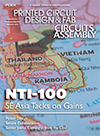Action Circuits services large component distributors, key names in the automotive industry and is the only approved programming center for Quicklogic Corp., Xilinx Inc. and Altera Corp. in Europe. The Luton, England-based company expects to program over 12 million devices this year.
The company's High Performance Circuits facility was named a member of the EPA's National Environmental Performance Track program, joining more than 300 facilities nationwide in their commitment to consistently exceed environmental regulation requirements. Teradyne is among only six companies in New Hampshire to be selected, the company said.
The National Environmental Performance Track program is designed to recognize and encourage top environmental performers -- those that go beyond compliance with regulatory requirements to attain levels of environmental performance and management that benefit people, communities and the environment, the company said in a statement.
The Teradyne plant qualified for the program through its performance, continuous commitment to environmental compliance and implementation of a strong environmental management system.
"Performance Track facilities represent a new generation of environmental leaders who have the vision to embrace the strategies that will protect the environment for generations to come," said Dan Fiorino, director of EPA's Performance Incentives Division.
COLLEGE PARK, MD - DfR Solutions and Interface Sciences Corp. have begun a joint investigation into potential improvements in CAF resistance through the application of ISC's molecular assembly and deposition technologies.
DfR Solutions, which has extensive experience in CAF experimentation and failure analysis, has identified this technology as a critical link in ensuring CAF robustness in high-density printed boards subjected to Pb-free reflow. The ISC process increases the uniformity and surface density of silane coupling agents on glass reinforcement - up to four times denser - compared with current technology, the companies said in a joint statement. This is expected to improve the intrinsic resistance of the fiber/epoxy bond to hydrolysis and cracking (during drilling), decreasing the influence of manufacturing defects on CAF. In addition, the process enables the deposition of novel surface chemistries that are expected to suppress filament formation. Substantial increases in CAF resistance are expected from the combination of these effects.
DFR and
Interface are currently establishing supply chain development channels with
glass, laminate and PCB manufacturing companies.
Accutronix is a privately-held electronics manufacturer with 47 employees in Owingsville, KY.
Mark Fulks, senior vice president at Key, becomes general manager for the Kentucky operation.
Key employs about 100 workers at its New Albany factory, and is constructing a 104,000 sq. ft. office and manufacturing facility in Jeffersonville, IN. The new plant is scheduled to be opened this summer.
The fourth-quarter net loss narrowed but sales declined sharply. Revenue and earnings were hurt by an unanticipated volume decline from a major customer that operates in a cyclical sector, the company said.
For the year the company generated $5.1 million in cash from operations. down from $5.5 million for 2003.
In a press release, John Caldwell, president and chief executive, said, "We expect to produce sequential revenue growth by the second quarter of 2005 and continue with positive momentum through the back half of the year."
For the fourth quarter the company reported a net loss of
$2.5 million on sales of $48 million. SMTC took $700,000 in restructuring
and other one-time charges. SMTC lost $2.6 million on revenue of $76.9 million a year ago.
For the year, the EMS maker posted a net loss of $4.5 million on net sales of $475.4 million.
For the quarter net sales were up 47%
increase from last year on higher demand for semiconductor capital equipment, aerospace and
defense, industrial and medical gear. The net loss was $1.3 million, vs. a net loss of $6.1 million.
For the year, the net loss was $4.5 million, vs. a net loss of $34.3 million in 2003.
The operating loss improved to $400,000 from $5.5 million
a year ago. Sequentially, fourth-quarter net sales decreased 10%, due to lower
demand for semiconductor tools.
Press Releases
- SMTA “Members of Distinction” Awards Announced
- Yamaha reveals software innovations to boost printing, mounting, and intelligent factory
- Innominds Partners with SIIX to Deliver Full-Stack ODM services for Intelligent Device-to-Cloud Solutions
- Phil Zarrow to Host SMT Bootcamp at BEST Inc. on October 15-16


